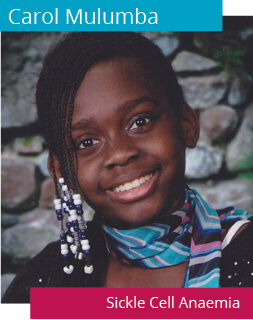Cord Blood Stem Cells Treat Sister’s Sickle Cell Anaemia
When Carol Mulumba was just three weeks old she was diagnosed with sickle cell anaemia. Sickle cell anaemia is a hereditary blood disorder common in Black, Asian, Middle Eastern and Mediterranean heritage. The red blood cells in sickle cell anaemia have an abnormal sickle shape, hence the name. Sickle cells can cause many problems: the cells do not move as freely through the blood vessels and can cause blockages which result in severe pain.
In the UK those with African and Caribbean heritage are most commonly affected by sickle cell anaemia. [1]
The only cure for sickle cell anaemia is a stem cell transplant. Carol’s parents were advised to store the cord blood of any future children they should have. Siblings have a 25% chance of being a perfect match for transplant. A study showed that survival rates are improved when using sibling cord blood compared to unrelated cord blood. Additionally, there is a vast shortage of stem cell donors from black and minority communities. Carol’s best chance of finding a stem cell match would be within the family. Unfortunately Carol’s condition had deteriorated so much by the time she was six years old that doctors advised her parents that she was in need of a stem cell transplant. Fortunately Carol’s parents had banked the cord blood of her younger brother Mark and he was a perfect match for Carol. After undergoing chemotherapy Carol was infused with her brother’s stem cells. Speaking about the transplant Carol said,
“A month after my transplant, testing showed that I was cured of sickle cell disease! I don’t have pain anymore. After my transplant, I started a brand-new life and I’m now a normal and healthy 13-year-old. All kids with sickle cell disease should be able to start a new life too.”[2]
READ MORE – SICKLE CELL ANAEMIACells4Life Experience: Blood Disorders
In 2012 Cells4Life released whole cord blood for the treatment of a blood disorder. The patient and donor were siblings.



